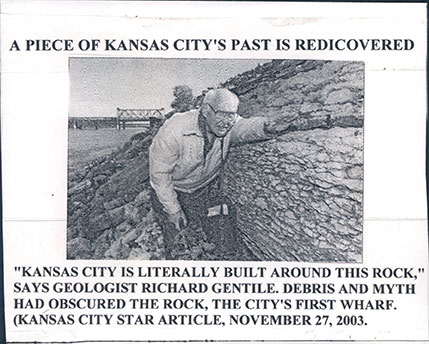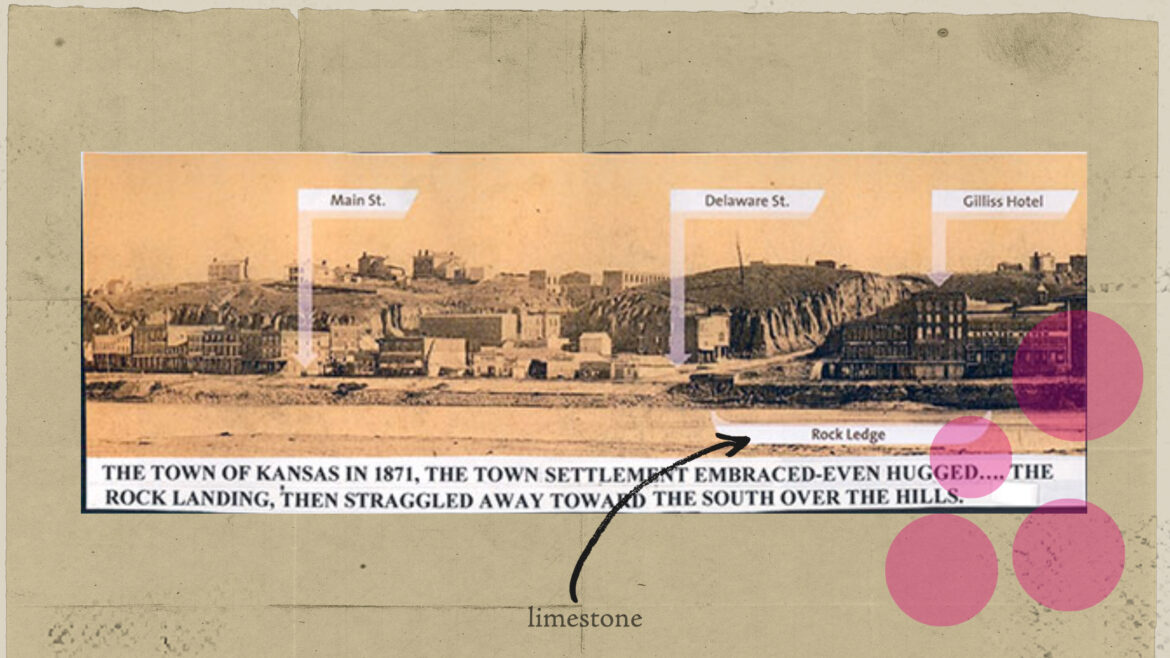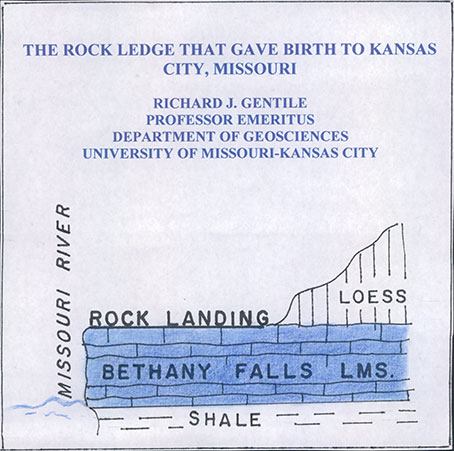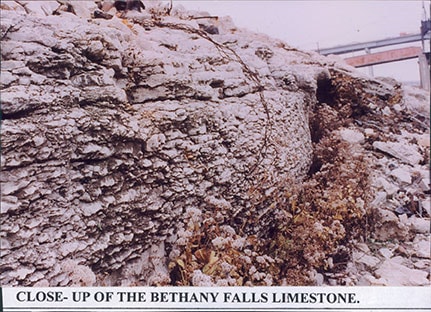curiousKC | How Bethany Falls Limestone Helped Build Kansas City Rock Provided a Natural Wharf, Stones for Our Homes and a Business World Beneath Our Feet
Published June 13th, 2022 at 4:38 PM
Above image credit: An old newspaper clipping showing geologist Richard Gentile who says, "Kansas City is literally built around this rock." Another clipping describes the benefits of using limestone for structures such as homes. (Vicky Diaz-Camacho | Flatland)Avid hiker and outdoor enthusiast Darin Good, 31, spends a good amount of time trekking through Kansas City’s outdoors.
He considers himself the “Indiana Jones type.”

“I just love seeing our natural history up close and personal,” he said. “It makes me feel connected to it, like I’m a part of it now too.”
Which is why he wanders through Kansas City’s many nature trails, finding gems along the way. One of Good’s favorites is an important Missouri limestone formation, visible in the Burr Oak Woods Conservation area. His adventures have taken him to where Bethany Falls limestone juts out of the earth.
The name, however, left him wondering: “How did Bethany Falls limestone get its name?”
Through research of his own, he’s learned a bit about the sedimentary rock’s role in the region, making this curiousKC exploration even more fascinating.
This specific limestone is a prominent formation in the region’s geological landscape, part of the Pennsylvanian-age Kansas City group. It has also become a staple in the residential landscape, Good learned.
Not only is Kansas City one of the only places in the world where this limestone layer protrudes from the earth, but it has also been locally quarried for quintessential Kansas City houses. Those limestone-heavy homes can be found in areas such as Midtown, Hyde Park, the Historic Northeast and the Volker area.
Local real estate agent Sarah Snodgrass is familiar with this style. She lived in one that was built in 1907 when she first moved to the area.

Although Snodgrass could not be reached for comment, she explained its history on her website.
“Also known as the Midwest Shirtwaist, this is an architectural style that was built from about 1900-1920 in Kansas City,” Snodgrass wrote.
The use of Bethany Falls limestone has always tracked alongside Kansas City’s development.
In 1833, riverboats docked at the rock shelf that would later be identified as Bethany Falls limestone, according to a lecture given by Richard Gentile, geologist and professor emeritus at the University of Missouri-Kansas City.

It was much more than just a port for riverboats, Gentile explained.
“The rock landing speeded up the development of Kansas City by two or three decades and is testimony to the benefit that geology has contributed to the building of a city,” he said in the lecture.
Gentile shared that a visitor in the 1850’s wrote: “The steamboat landing is perhaps the best on the Missouri River. In fact, the entire riverfront constitutes a natural wharf where any kind of vessel might discharge and pick up freight safely.”
But not everyone was impressed with the natural wharf, which one visitor described as “depressing.” Nonetheless, Gentile wrote, “The town of Kansas was a frontier boom town.”
He along with other area geologists have compiled well-documented accounts of how it was found and its earliest uses.

“Kansas City is literally built around this rock ledge,” Gentile told the Kansas City Star in 2003. He called it “Kansas City’s birthstone.”
In geology research papers, Bethany Falls limestone is identified as one of many layers of bedrock in the area. This one is part of the Swope Formation, according to a 12,225-page report by the Missouri Geological Survey (MGS).
Bethany Falls limestone derives its name from where it’s found in northwest Missouri. It’s a member of a Kansas City formation “consisting of 15 to 25 feet of limestone (locally called ‘cotton rock’) underlying Galesburg shale and overlying Ladore shale.”
Hylan Beydler, information officer with the Missouri Department of Natural Resources, shared a few more fun facts about Bethany Falls’ history.
“Bethany Falls is a geologic limestone unit named after the waterfall on Big Creek in Bethany, Missouri, which flows over this limestone unit,” Beydler said. “Many of the underground storage facilities in old limestone mines are completed in the Bethany Falls.”
The availability and access to Bethany Falls limestone led to the development of an enormous underground storage industry in the Kansas City area. SubTropolis, a 55 million-square-foot artificial cave carved into the bluffs above the Missouri River, has even claimed the title of the “world’s largest underground business complex.”
Gentile and other geologic experts outlined some concerns, one being that as the metro area developed, more of the area’s natural wonders were slowly built upon, hidden and erased.
But Kansas City’s literal bedrock is still visible, for those who go looking like Good.

For the curious, a few interactive resources:
- Check out the Missouri Department of Natural Resources’ geologic maps and applications: (https://dnr.mo.gov/land-geology/maps-data-research). Various layers can be turned on and different base maps as well.
- This opens the Geosciences Technical Resource Assessment Tool (GeoSTRAT) tool to Bethany and shows the creek: https://bit.ly/3POmwd8
- Revisit the Kansas City Group’s geology 1965 Field Trip report here to see sketches, writings and diagrams of limestone formations across the metro.
Vicky Diaz-Camacho covers community affairs for Kansas City PBS.





